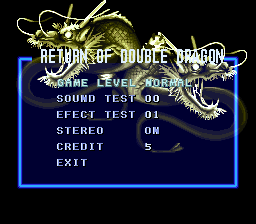Super Double Dragon
| Super Double Dragon |
|---|
|
Also known as: Return of Double Dragon: "Sleeping Dragon" has Awoke (JP)
|
rushed - adjective, /rʌʃt/
- Very busy.
- "I was so rushed today, I didn't have time to eat lunch."
- Done in haste; done quickly.
- "My rushed attempt at an essay received a predictably poor grade."
- Abounding or covered with rushes.
- Super Double Dragon.
| To do: There's A LOT more: unused music, more unused graphics, unused text, etc! |
Contents
Sub-Pages
| Development Info |
| Prerelease Info |
Unused Graphics

This silhouette was supposed to be used whenever the characters got on fire, like when blown up by a bomb. They probably forgot to add it in during all that rushing they were doing, so somebody did not set up us the bomb.
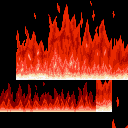
This fiery background was supposed to be in the pits and flames of the Japanese version's final area.


The game was supposed to have cutscenes throughout the game, but they weren't implemented due to, you guessed it, rushing it out the door!
Here are portraits of Billy and Jimmy. Hilariously, Jimmy is sporting a mullet.


Cutscene portraits obviously meant for after defeating the first two bosses, Steve and Jackson, respectively.

Japanese Kana that would've gone along with the cutscenes, had the game not been rushed and they were actually implemented.
Unused Music
Track 10 in the Japanese version was meant for the battle against Duke after going through the rest of the Great Hall.
Regional Differences
| This page or section needs more images. There's a whole lotta words here, but not enough pictures. Please fix this. |
The Japanese release is a slightly later build of the game and features several significant differences and additions from its Western counterpart.
Title Screen
| Japan | International |
|---|---|
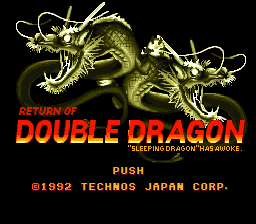 |
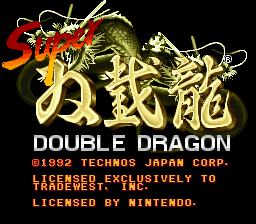 |
Only the Japanese version has a flashing "PUSH START BUTTON" text.
Mode Select
| Japan | International |
|---|---|
 |
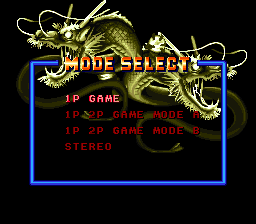 |
- The blue box around the settings is brighter and slimmer in the Japanese version, and it has the game's name in place of the big "MODE SELECT" icon seen in the international versions. Also, the text's color is different: red in the international versions and light blue in the Japanese version.
- In the international versions, the player moves around the settings by pressing Select and chooses a setting by pressing Start. In the Japanese version, the settings are browsed by pressing either Select, Up, or Down, and the settings are chosen by pressing any of the other buttons except L and R.
- An Option Mode is included on the Japanese version, allowing the player to adjust the game's difficulty setting from one of three settings (Easy, Normal, and Hard), as well as listen to the game's music and sound effects. The Stereo/Monaural settings are the only ones here that are selectable in the international versions.
Gameplay
- In the Japanese version, the player can retrieve a boomerang after throwing it. This action is not possible on international versions.
- Only in the Japanese version can the player hit an opponent more than once successively with the hurricane kick.
- In the international versions, Billy and Jimmy can both perform a reverse roundhouse kick. In the Japanese version, Jimmy instead uses a regular roundhouse kick to further differentiate his fighting style.
- The enemy placement is different between versions.
- Weapons such as knives and incendiary bombs do less damage in the Japanese version.
- On the Japanese version, enemies can duck end combo blows, thus preventing the players from finishing their combos.
- In the Japanese version, the final Mission features two additional sections before the final battle.
- There is no ending text in the Japanese version.
Music
Many tracks were shuffled around between versions. The only tracks that are the same between versions are Mission 2's and Mission 6's, as is the credits theme.
- The international versions' title screen music is also used in Mission 7 and is not used in the Japanese version.
- Mission 1's music on the international versions is used for Mission 4 in the Japanese version.
- The track heard in Mission 3 on the international versions is used in Mission 5 on the Japanese version.
- The music for Mission 4 heard on international versions is used in Mission 7 in the Japanese version.
- The international versions' Mission 5 music is used in the Japanese version for the title screen and the very end of Mission 7.
- Pages missing developer references
- Games developed by Technos Japan
- Pages missing publisher references
- Games published by Technos Japan
- Games published by Tradewest
- SNES games
- Pages missing date references
- Games released in 1992
- Games released in October
- Games released on October 16
- Games with unused graphics
- Games with unused music
- Games with regional differences
- To do
- Needs more images
- Double Dragon series
Cleanup > Needs more images
Cleanup > Pages missing date references
Cleanup > Pages missing developer references
Cleanup > Pages missing publisher references
Cleanup > To do
Games > Games by content > Games with regional differences
Games > Games by content > Games with unused graphics
Games > Games by content > Games with unused music
Games > Games by developer > Games developed by Technos Japan
Games > Games by platform > SNES games
Games > Games by publisher
Games > Games by publisher > Games published by Technos Japan
Games > Games by publisher > Games published by Warner Bros. Games > Games published by Midway Games > Games published by Midway Home Entertainment > Games published by Williams Entertainment > Games published by Tradewest
Games > Games by release date > Games released in 1992
Games > Games by release date > Games released in October
Games > Games by release date > Games released in October > Games released on October 16
Games > Games by series > Double Dragon series
